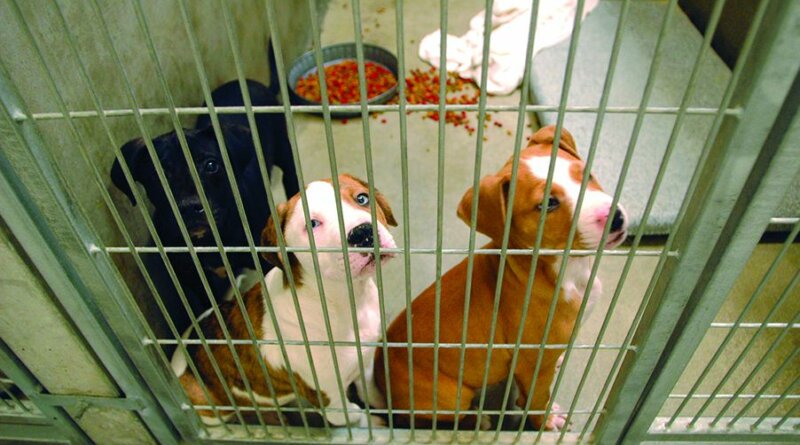Overcrowded animal shelters and overworked shelter workers: What can be done?
The difficulty in obtaining routine veterinary care may have contributed to the surge in pet overpopulation – but since that’s a long-term problem in itself, what can we do about all these dogs and cats right now?
I haven’t been volunteering at my local shelter lately; I’ve had my hands full with work stuff, family stuff, and my own three dogs. But I was running errands the other day with a little bit of time on my hands and decided to stop by and say hello to the director and the head RVT (registered veterinary technician) – the folks I’ve worked with and have known for the longest time, all 16 years I have lived in this town.
When I walked in, I could see that the director was absorbed in conversation with the front counter staff. I took a walk through the adoption kennel while waiting for her to be free. In the month of December, in an effort to get more pets “home for the holidays,” the shelter had waived the cost of all dog and cat adoptions, and I had been happy to see lots of photos of newly adopted pets and their new owners on the shelter’ Facebook page. Given all the photos I had seen, I hoped the adoption kennel would be only lightly populated.
I couldn’t have been more mistaken. Every single one of the 28 kennels contained at least one dog, and several contained two or even three dogs. As I walked along the kennel row, dismayed, another RVT on the staff, whom I’ve known for at least seven or so years, came into the adoption kennel through another door. We greeted each other, and I told her I was just killing time, waiting to say hi to the director. She said she was just taking a momentary break, and she joined me on my walk around the perimeter of the kennels, which are arranged in the center of the room. She gave me details about at least a dozen of the dogs as we walked – some of the hardest-luck cases and some of her favorite wards. There were a lot of sad stories.

We did a similar walk around the perimeter of the “isolation” part of the building – a mirror version of the other room, also with 28 kennels. These pens were even more full, with two to three dogs in every kennel but the ones that had large “DANGER” signs on them – indicating dogs who have proven to be dangerously aggressive to other dogs and/or humans.
There was also one pen with a single dog in in who did not have a “danger” sign on his door. He looked to be an elderly Labrador, very thin, with a hind leg that he could not put weight on and which stuck out at a crazy angle. I read his cage card; it indicated he was “seized” – a police case of some kind – and that he was 19 years old. I raised my eyebrows at my friend. “That’s what the owner told police. We think he’s more like 12 years old or so. But we’re not sure what we’ve going to do with him. He is such a sweet boy.”
As we talked about that dog, we walked into a hallway in the office part of the shelter building, and ran into the shelter director. I told her how disappointed I was to see how full the shelter was. She said, “TELL me about it! I waived adoption fees all December, just to try to get some animals out of here. But it feels like for every one that left the building, five more came in!”
My friend the RVT joined our conversation. She had just been on the phone with the police discussing the cruelty and hoarding case that involved the skinny, crippled old Lab. “We had to seize 24 animals the other day, cats and dogs both – and it’s been quite a job, making room for them!” she said. “It’s crowded and stressful here,” she said, “But at least the poor animals will be fed and receive medical care!”
I asked her about the plan for the old Lab. She said, “You know, that’s exactly the kind of dog that we like to splurge on – to spend extra money to make sure he gets the time and medical care he needs to recover and find a happy home for the rest of his life. But it’s very hard to justify the time and money right now, with so many other needy animals. There is an 8-month-old Boxer with a broken leg who needs surgery, too – and we just spent a fortune treating a bunch of parvovirus cases.”
“And in the meantime,” the director added, “I have people coming in screaming at the front counter staff because we can’t take their dogs. We’re not taking any owner-surrendered animals right now; we have no room for them! This lady came in the other day mad because we wouldn’t take her three dogs. She was screaming, ‘This is your job! Why don’t you do your damn job?’ I wanted to tell her, ‘Why don’t you come in the back with me and tell me which dogs I should kill to make room for yours!’ ”
The RVT said, “Even the shelters and rescues that we’ve been working with for years, who take some of our excess animals from time to time – they are maxed out, too. At the moment, we’re hearing, ‘Sorry, we’re full!’ from every group we know.”
I asked my friends, “What do you think is happening? Why so many stray and surrendered animals right now?”
The RVT said, “I think that since COVID started, and so many veterinary practices were either shut down or taking only emergency or reduced caseloads, a lot of animals didn’t get spayed or neutered – and now we’re a couple or a few dog and cat generations into a population boom. We’re just drowning in puppies and kittens – more than ever – and also taking in a lot of 1-year-old dogs and 2-year-old dogs that people say they ‘just can’t keep anymore.’ I think there are a ton of ‘accidental litters’ that have been born over the past couple of years, due to the fact that people haven’t been able to get into a clinic and get their animals sterilized. And each litter of unneutered pups or kittens that are given away tends to create another!”
We didn’t talk for much longer; I didn’t want to keep them from their work. I made a donation – every little bit helps – and told them I’d be thinking about anything I could do to help with the limited amount of time I’ve been finding myself with lately.
Solutions: What can be done?
Being a writer, my go-to is to try to generate some buzz by writing about the plight of shelters everywhere, in an effort to get the word out to the animal-loving community: Please help your local shelters in any way you can! They are struggling under the weight of too much to do, and too little funding (almost always) to do it with. Fostering, donations, asking friends and family for donations – these things help a lot. Also, setting your Amazon account to an AmazonSmile account and choosing your local animal shelter as its charitable beneficiary helps, too. Amazon donates a tiny percentage of your AmazonSmile purchases to the charity of your choice, but if enough people in your community select your local animal shelter as their charitable recipient, it adds up!
While donations can’t add up to an immediate increase in the amount of space a shelter has, it frees up funds for buying food and medicine for treating animals (yes, some shelters have to balance their funds for food against funds for medical treatment). Above all, regular donations give shelters the ability to hire more help. It takes a lot more time to keep kennels clean when they are holding two and three dogs apiece than just one, and this alone translates into better health for the wards.
I wish I lived in a community with a low-cost spay/neuter clinic that I could support; I’d fund-raise for them year-round. I do believe that almost any cost for spay/neuter services is a barrier for many of the people in the relatively low-income community where I live.
On social media, I follow a rescue group in a nearby county – one that focuses on what they call “home to home” adoptions. They try to help people find qualified new homes for pets that people can’t keep (for whatever reason), by providing foster care, training, medical help, and grooming and then screening prospective new owners, so that the dog doesn’t end up in another home that might not work out. This keeps many dogs out of their local shelter – and also out of the arbitrary and often sketchy world of Craigslist rehoming. The fact that it’s a private organization, with no obligation to take on more dogs than they can handle, helps the group maintain financial stability (though I know that emotionally it can be hard to turn away needy dogs when the demand for placement is high).
What works best in your area for helping homeless dogs and overcrowded shelters? Any and all good ideas are welcome; you never know what solution might work perfectly for another shelter.




